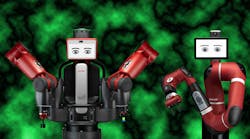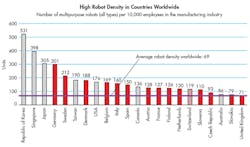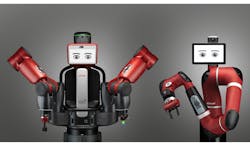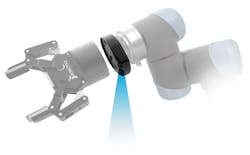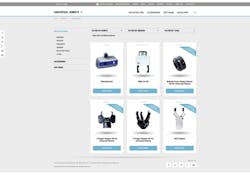Advanced Robotic Systems: The Manufacturing Labor Force of Tomorrow
This file type includes high resolution graphics and schematics when applicable.
The automation industry is seeing a shift in its labor force. As many current workers get ready to retire, a younger workforce has yet to arrive to take its place. In response to this shortfall, the advanced robotic market has grown significantly. Advanced robotic systems and collaborative robots are taking center stage at a time when manufacturing industries need them the most.
Labor Woes and the Future of Robots
The graph above highlights the number of multipurpose industrial robots in the manufacturing industry. The leading manufacturing countries in the world are all above the average density of 69 robot units. (Image courtesy of the International Federation of Robotics)
As reported by Deloitte.com and the Manufacturing Institute, the United States will face a labor shortage of 3.5 million workers in the years leading up to 2025. It is predicted that 2 million of those jobs will most likely go unfilled due to the skills gap. The current workforce is close to retirement; by 2025, 2.7 million professionals will exit the manufacturing workforce.
According to Jennifer McNelly, president of the Manufacturing Institute, the challenge will “only grow as the demographics of our workforce evolve with retirements, new technological advances requiring a higher level of training and certification, and our K-12 education system, which continues to lack the necessary focus on STEM education.”
This future labor shortage does, however, present an opportunity for robotic systems. The use of industrial robots has been around for the last four decades. These are mostly large robotic arms programmed to lift heavy objects, weld, paint, and perform other stationary tasks. Simpler and mundane tasks (e.g., taking out the trash) are performed by manual labor. This is primarily because of the inexpensiveness of manual labor compared to buying and installing robotic systems as well as the capabilities and safety of those robots.
Advances in robotics—especially collaborative robots, robotic safety, and a faster return of investment—have increased the use of robots. According to a 2015 study from the Boston Consulting Group, the current percent of industries installing advanced robots are around 2% to 3% annually. They predict that this will increase to 10% annually by 2025.
In certain industries, the use of robots for manual labor may see a jump of 40% or more. The price of hardware and software is projected to decrease by more than 20% within the same timeframe. The performance of robots is expected to increase around 5% each year.
The study conducted by the Boston Consulting Group analyzed 21 industries in the world’s 25 leading manufacturing export economies. This accounts for more than 90% of the global trade in goods. By analyzing five common robot setups for investment, cost, and performance, they developed a future industry view of more than 2,600 robot-industry-country combinations and their likelihood of adoption by the industry. Their predictions are:
- By 2025, robots will perform 25% of all labor tasks. This is due to improvements in performance and reduction in costs.
- The United States along with Canada, Japan, South Korea, and the United Kingdom will be leading the way in robot adoption.
- The four industries leading the charge are computer and electronic products; electrical equipment and appliances; transportation equipment; and machinery. They will account for 75% of all robotic installations till 2025.
- Due to a wider adoption of robots, especially for small manufacturers, worker output will increase by 30%.
- Labor cost is expected to decrease 18% to 25% in countries like the United States, China, Germany, and Japan.
- Leading countries in robot adoption will see an improvement in national cost competitiveness. For example, South Korea will see a 6% point improvement relative to the United States by 2025 if all other factors stay the same; driving up their manufacturing output. High-cost countries like Russia and Brazil will see their relative cost competitiveness decrease.
- Manufacturing tasks will become more complex with the adoption of more robots. Low-cost laborers will be required to master new skills and work in conjunction with the robots in order to succeed, and to continue working in the advanced manufacturing plants.
The Rising Role of Robots
Baxter and Sawyer are the friendly collaborative robots, or cobots, from Rethink Robotics. They not only perform physical tasks, but are self-learning and continuous-improvement equipment for the manufacturing line. (Image courtesy of Rethink Robotics Inc.)
As previously mentioned, 25% of all labor tasks will be completed by robotic systems. Leading the charge are collaborative robots, or cobots. In September, the International Federation of Robotics released the World Robotics Report 2016. The report predicts that between 2017 to 2019, sales of industrial robots will increase by 13% and that human-robot collaboration will have a breakthrough period. This enables humans and robots to work side-by-side safely without fences, increasing production, efficiency, and quality.
Jim Lawton, chief product and marketing officer for Rethink Robotics has highlighted the importance of cobots in the engineering workplace. Lawton describes two types of labor: tasks that people are well-suited for, which involves critical thinking, dexterity, flexibility, and other qualities unique to humans; and labor tasks that are menial and repetitive.
The latter category includes pick-and-place, sorting, and simple filtering jobs that—whether due to space, safety, or high cost—are performed by people rather than robots. “The person became the plug, meaning that they would take on the task of what the traditional robot could not do,” says Lawton. This is where cobots come into play. “The average age of a person in manufacturing is 58 years old,” he adds. The younger workers entering the market are not looking to perform these labor-intensive and menial tasks.
The benefits provided by cobots are high because they are easy to deploy, offer safe working conditions, and are easy to repurpose. Many small companies have short product lifecycles or have several tasks to be completed. In large companies, like a car manufacturing plant, robotic arms are stationary. According to Lawton, 65% of all robots are used in the automotive industry.
Cobots are easy to move from job to job and reprogrammable to suit the current needs of the facility. The user can simply add more logic and use it in conjunction with IoT sensors, data, and analytics. Baxter and Sawyer from Rethink Robotics use vision systems to implement analytic learning. The improvement process is done autonomously.
The cobots’ learning capabilities move manufacturing lines from a reaction to prediction. The cobots learn and manipulate the line to help production efficiency. As Lawton noted, these robots “need to be a PC with arms.”
Several companies are focusing on cobots. Universal Robots has long been a collaborative robot company with its UR robot arm series. These robots can be used right next to the operator without the need for safety cages or light curtains. Now the firm is introducing its Universal Robots+ online store. It allows users to not only select their robot, but also end-effectors and accessories they want to use in conjunction with the robot.
Universal Robots is providing a one-stop solution with parts and accessories that are guaranteed to work with the robotic arm. An example would be the line of parts from Robotiq. The company offers end-effectors, mounted cameras, and force-torque sensors that can help detect, scan, and move a part in place.
The MiR100 is an autonomous robotic assistant that can traverse any floorplan, such as a manufacturing plant or hospital floor, for the purposes of delivering goods and equipment. The cobot has built-in sensors for guidance and an access point for web-browser interface control. (Image courtesy of MiR)
Not all cobots are robotic arms. The MiR100 is a multipurpose, self-automated, in-house transportation unit. The benefit of this robot is its ability to transport supplies over any floor layout on its own. The cobot’s present main targets are industrial sites and hospitals, both of which require transport of parts and medication.
The MiR100 learns the plant floor by scanning the layout into the robot’s computer. The cobot can plan a route now knowing the floorplan. On-board sensors help it avoid people and obstacles, and can execute a re-plan route if necessary. The MiR100 is Cat 3 performance level safe.
The MiR100 also has its own access point, which allows users to pull a web-browser interface for full access control. According to Ed Mullen, MiR’s vice president of sales for North America, one can operate an entire fleet of MiR100s. They work in tandem, and specific orders can be issued to dispatch the closest robot for a task.
How to Integrate Robotic Enhancements
The world is getting ready to embrace robots and cobots. Jeff Burnstein, president of the Association for Advancing Automation (A3), recently testified in front of the U.S. House of Representatives’ Energy and Commerce Committee about the state of advanced robotics. Burnstein spoke to the Subcommittee on Commerce, Manufacturing and Trade about how robots will be disruptive technology for many industries across the United States.
In an interview with Machine Design, Burnstein highlighted the automation advances of advanced robotics, including improved productivity, speed and flexibility of production, predictive maintenance, less downtime, Internet of Things (IoT) implementation with sensors, data collection, and increasing the manufacturing industry.
Burnstein also acknowledged that because of robotic automation, many companies have been able to keep manufacturing within the U.S. instead of looking abroad for production services. Last March, A3 released Technical Specification 15066 (TS15066), a guideline for cobots. Specifically, TS15066 highlights the design of collaborative robot systems, including such important aspects as:
- Definition of a collaborative robotic system.
- Important characteristics of the safety-related control system for collaborative operation.
- Identification of factors to be considered in the design of a collaborative robot system.
- Built-in safety-related systems that can be used effectively in a collaborative operation, along with requirements for their effective use.
- Steps in implementing a collaborative application.
- Guidance on maximum allowable speeds and minimum protective distances, as well the formula for determining the protective separation distance.
- Data to help determine threshold limit values for power and force-limiting to avoid pain or discomfort on the part of the human operator.
To prepare for the new role robotics will play in manufacturing, industries need to understand the global landscape. They will need a clear understanding of the trends in robot adoption, including the price point and the performance capabilities, and how these factors will change in relation to the total cost of labor. These companies will also have to know how to benchmark the competition and be aware of how their competitors are handling robotic integration.
Companies will be required to stay current with technological advances. If a firm is considering investing in robots and see that new gripping features or flexibility are on the way, they may choose to hold off on investing until the right moment. Lastly, they will need to prep the workforce and the organization. They should also take into account how the labor force will need to change in the next decade.
Workers will be required to learn more complex tasks. Skills such as programming, automation implementation, and experience with robotic systems will become crucial. These employees will be sought out as adoption grows. Companies should also start to adapt their facilities for robotic systems. This includes upgrading existing networks (power and data) and adjusting handling and operation procedures. Organizations could also start to train their existing or incoming workforce by providing certification in future robotic systems.
This file type includes high resolution graphics and schematics when applicable.
